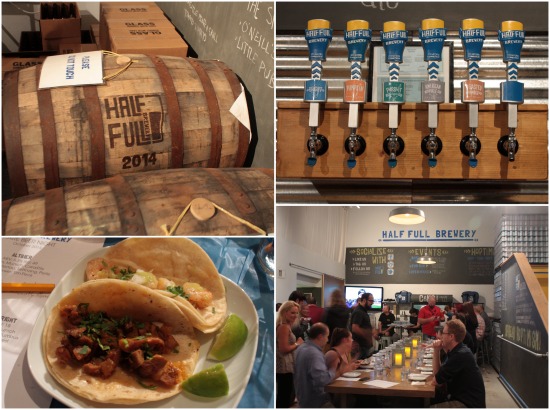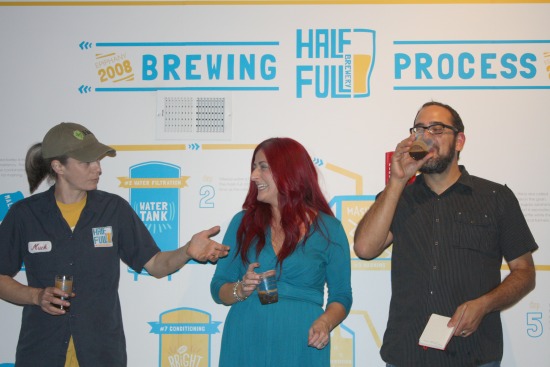CT Beer Week Recap Finale: A Look At Gose + Rare Beers @ Half Full Brewery
 The third act is here, the lights are low, and the curtain is set to drop. This is the final post on the Connecticut Beer Week that was, 2014 edition. The first two focused on food and beer pairing, while these last two recaps are more food-accompanied beer events. Make sense? No? Good, because there's no use in telling the audience a story they already know.
The third act is here, the lights are low, and the curtain is set to drop. This is the final post on the Connecticut Beer Week that was, 2014 edition. The first two focused on food and beer pairing, while these last two recaps are more food-accompanied beer events. Make sense? No? Good, because there's no use in telling the audience a story they already know.
Let's ease back into the narrative where we left off in act two, with sours, and the ancient art of brewing beers we callgose. This tart, slightly salty beer is at least 1,000 years old as a style, evidenced by the fact it was actually mentioned in writing by the Holy Roman Emperor Otto III, who ruled during the last millennial turnover. The name gose (say "go-zuh," like Janine Melnitz pronouncing the first name of the Gozerian), comes from the town of Goslar in Saxony, which is slightly famous for its medieval old town, and for introducing this refreshing beverage to neighboring Leipzig, where its popularity exploded.
To give an example of how remote even a thousand years in the past is, just look at the shape of a bottle of gose. That's a modern bottle from Gosebrauerei Bayerischer-Bahnhof Leipzig. The long, narrow neck is topped with a swing cap in this case, but the shape used to actually be part of the cap. Brewers would fill the bottles, then let the yeast and souring bacteria form a solid pellicle - the beer effectively growing its own cork. More sanitary methods are used now, but the traditional bottle shape has endured.
That's a modern bottle from Gosebrauerei Bayerischer-Bahnhof Leipzig. The long, narrow neck is topped with a swing cap in this case, but the shape used to actually be part of the cap. Brewers would fill the bottles, then let the yeast and souring bacteria form a solid pellicle - the beer effectively growing its own cork. More sanitary methods are used now, but the traditional bottle shape has endured.
I met with OEC Brewing founder Ben Neidhart at Coalhouse Pizza to learn about gose and try a few examples of the style, including newer styles from BFM La Douze and Hitachino Nest Anbai, and the Bayerischer-Bahnhof Leipzig gose. (links lead to reviews)
"Goslar is a heavy mining town, so it's possible the water there is naturally slightly salty, which is what gives the gose that character," Ben explained. "They needed to add salt to the water when it started to be mass produced in Leipzig starting around 1738, and from there it became the single most popular style of beer in Germany until the breweries were bombed out of existence in WWII."
Brewer Thomas Schneider revived gose in July of 2000, nearly a thousand years after its first historical record, in an abandoned 19th century train station which was the old terminal for the Bavaria-Leipzig train line, giving "Bayerischer" Bahnhof its name.
The fourth gose we tasted was Baciami Lipsia, from Birrificio del Ducato, in Roncole Verdi Di Busseto, Italy. Baciami Lipsiameans "kiss my lips" - it is made with pink Himalayan salt, and aged and soured for nine months in wine barrels. The salt content in La Douze and Anbai is mostly only detectable as a flavor enhancer to the other ingredients - and fractionally noticeable on its own in the Leipziger - but wholly apparent in the Italian beer.  Baciami Lipsia possesses a very strong, surpassingly grapey sourness. The brewers at Ducato turned up the acidity, then relied on the barrel aging and salty finish to smooth everything out. This gose is darker in color than most, like gold in a bad mood. It remains fruity and somehow more rustic than the mellow Leipziger, and I'd suggest pairing it with rich food - maybe a chunk of Midnight Moon chèvre or a smoked gouda - to round off those sharp edges and let the grapes shine through.
Baciami Lipsia possesses a very strong, surpassingly grapey sourness. The brewers at Ducato turned up the acidity, then relied on the barrel aging and salty finish to smooth everything out. This gose is darker in color than most, like gold in a bad mood. It remains fruity and somehow more rustic than the mellow Leipziger, and I'd suggest pairing it with rich food - maybe a chunk of Midnight Moon chèvre or a smoked gouda - to round off those sharp edges and let the grapes shine through.
"Beer and cheese, you say? How about beer and tacos?" Yes, I say to that, and so did the crew at Half Full Brewery, who hosted guests at their location in Stamford alongside food from Casa Villa this past October.
The brewery holds a monthly rare beer night featuring food from various sources, and four one-off beers collaborated on with lucky members of the community. These are ticketed events, and attendance is capped at forty people, so they tend to sell out.
The night began with Casa's chips, salsa, guacamole and an altbier produced with friend of the brewery Tim Peck. The alt was brewed with mostly German ingredients: Munich and Cara-Pils malts, Hallertau, Tettang and Perle hops, and poured a cloudy brown with a persistent head. The aroma was slight and malty, but a solid, biscuity flavor pervaded through a notably light body. It was a good beginning to the night.  Attendees were invited to mix and match from a temporary taco bar set up by Casa Villa, and featuring shrimp, carnitas, and al pastor with various fixings, while staff poured half full pints of Imperial Bright at the tables. The beer was put together for the event in a short amount of time by the brewery using the same ingredients as their flagship Bright Ale, but in higher quantities. The result was a darker, unfiltered "bright" ale, with a 9.5% alcohol punch, and a gentle hop aroma. It was apparent upon tasting that this beer had needed to spend more time in the tanks before serving, as a large amount of unfermented wort remained in the mixture, leaving it excessively sweet.
Attendees were invited to mix and match from a temporary taco bar set up by Casa Villa, and featuring shrimp, carnitas, and al pastor with various fixings, while staff poured half full pints of Imperial Bright at the tables. The beer was put together for the event in a short amount of time by the brewery using the same ingredients as their flagship Bright Ale, but in higher quantities. The result was a darker, unfiltered "bright" ale, with a 9.5% alcohol punch, and a gentle hop aroma. It was apparent upon tasting that this beer had needed to spend more time in the tanks before serving, as a large amount of unfermented wort remained in the mixture, leaving it excessively sweet.
Next up was a trio of mole stouts via the imaginations of Dan and Kristien Del Ferraro of OmNomCT. These used Special B and roasted wheat malts along with a good dose of Magnum hops to create a base, 5.5% stout of 44 IBUs used as a control group. It had a great nose from the hops and that roasty malt bill, and was pretty tasty on its own.  The second group added cinnamon, peppers and tea into the mix, along with graham crackers (if I'm not mistaken) which were apparent on the nose, while the tannins added an entirely different bitterness. Heat from the cinnamon and pepper was apparent on the back end. I could get into this.
The second group added cinnamon, peppers and tea into the mix, along with graham crackers (if I'm not mistaken) which were apparent on the nose, while the tannins added an entirely different bitterness. Heat from the cinnamon and pepper was apparent on the back end. I could get into this.
The third batch retained the tannins, but added cloves and considerably more peppers - both in amount and variety. Muddled spice jumped out of the aroma of this one, and it was deeper and more savory than the first two. Hot, microscopic knives poked their way down my throat as I made my way through this version of the stout.
The last experimental beer of the evening was a pineapple pale ale, from the appropriately named Half Full intern/brewer Andrew Porter, who spoke about the Cascade hops he used for their citrus aroma and flavor, but telling us he soaked the pineapple he used in vodka before adding it to the beer, post-fermentation. The fruit was apparent on the nose of this beer, along with a few more raw, grainy notes. The pineapple was subtle in the beer, and I definitely liked it as an additive but, at just 18 IBUs, I think this recipe could have doubled the amount of hops to positive effect.
After this, it was time for the Half Full crew to strike the evening's set and turn us loose into the night. We'll close the third act of this recap series similarly, with a new experience behind us, and the whole world of craft beer just waiting, everywhere out there.
























